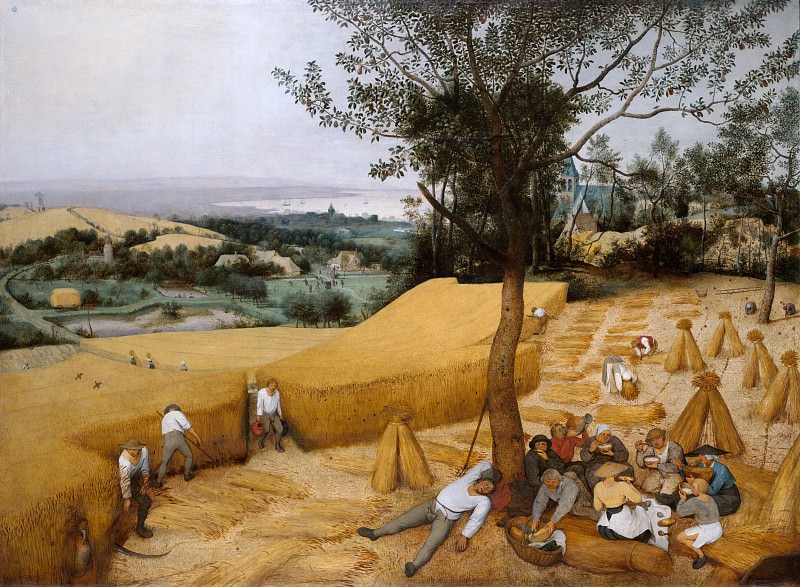Pieter Bruegel the Elder ca. 1525–1569 Brussels) – The Harvesters Metropolitan Museum: part 2
Metropolitan Museum: part 2 – Pieter Bruegel the Elder ca. 1525–1569 Brussels) - The Harvesters
Edit attribution
Download full size: 3755×2751 px (3,9 Mb)
Back to album: Metropolitan Museum: part 2
In the art of the Netherlands in the sixteenth century, Pieter Bruegel appears as a seminal figure. The author’s cycle of oil paintings on wood, The Seasons, dated 1565, shows the annual cycle of natural changes. Unfortunately, only 5 of the painter’s 6 paintings have survived. Other researchers believe that there were 12 paintings. The works were painted for the collector Nicholas Jonghelinck. "Hunters in the Snow" depicts presumably December through January.
Description of Peter Brueghel’s painting "The Seasons"
In the art of the Netherlands in the sixteenth century, Pieter Bruegel appears as a seminal figure. The author’s cycle of oil paintings on wood, The Seasons, dated 1565, shows the annual cycle of natural changes. Unfortunately, only 5 of the painter’s 6 paintings have survived. Other researchers believe that there were 12 paintings. The works were painted for the collector Nicholas Jonghelinck.
"Hunters in the Snow" depicts presumably December through January. Several hunters with their prey and dogs are heading toward town. To their left is a campfire where a pig is being set on fire. In town, people are having fun on a frozen pond. The painting is calm and harmonious in scale and mood.
"Dusky Day." - A painting about early spring (February-March). One peasant is trimming willow branches, another nearby is tying them into a bundle. Another company is having fun and walking around, eating waffles. This fragment is reminiscent of carnival festivities. In the thaw, the water in the river rages, nailing the remains of the ships to the shore. The mood of the painting is melancholy and restless.
"Haymaking" reflects the labor of the peasants in June and July. Women and men are busy making hay. There are many shades of yellow and orange in the painting, which creates an overall joyful mood.
"Harvest" takes place in late summer. The painting depicts August through September. One team of reapers is working, while others are busy snacking in the shade of a tree. Nearby, a weary man is immersed in sleep.
"Return of the flock" refers to November. The shepherds are hurrying to drive the herd from the summer pastures. The blackening sky shows that inclement weather is coming.
In "The Seasons" Bruegel depicted in detail the appearance of nature in different months. But in the foreground of his work are the figures of peasants, with their traditional work for the different seasons. Harmonious coexistence of nature and man perfectly conveyed in the works of the artist.
Кому понравилось
Пожалуйста, подождите
На эту операцию может потребоваться несколько секунд.
Информация появится в новом окне,
если открытие новых окон не запрещено в настройках вашего браузера.
You need to login
Для работы с коллекциями – пожалуйста, войдите в аккаунт (open in new window).


![Metropolitan Museum: part 2 - El Greco (Greek, Candia [Iráklion] 1540/41–1614 Toledo) - View of Toledo](http://cdn.gallerix.asia/j/_EX/776165577/221017.webp)


![Metropolitan Museum: part 2 - El Greco (Greek, Candia [Iráklion] 1540/41–1614 Toledo) - The Miracle of Christ Healing the Blind](http://cdn.gallerix.asia/j/_EX/776165577/221014.webp)














COMMENTS: 1 Ответы
Итак, значит тех, кто выходит по осени с серпами или косами на поле, засеянной пшеницей или рожью, в России называют сборщиками урожая? А слово жнец навсегда забыто? Где вы, патриоты родного языка?
You cannot comment Why?
In Pieter Bruegel the Elders The Harvesters, we are presented with a panoramic view of a rural landscape during the peak of the harvest season. Dominating the foreground is a vast field of golden wheat, meticulously rendered to convey its ripe fullness. Several figures are actively engaged in the harvest. Some are scything the wheat, their movements economical and practiced. Others are binding the cut stalks into sheaves, which are then stacked in neat rows throughout the field, awaiting further processing.
The scene extends backward to reveal a village nestled amongst trees and rolling hills. Cottages with thatched roofs dot the landscape, and a church spire rises in the distance, suggesting the communitys spiritual life. A body of water, perhaps a river or bay, can be seen further in the background, with ships in the distance hinting at trade and connection to the wider world.
The painting captures a moment of both arduous labor and respite. In the shade of a large tree, a group of harvesters is taking a break, enjoying a communal meal. Some are eating, others are resting, with one man even deeply asleep, his body sprawled on the ground, a testament to the sheer exhaustion of their work. This juxtaposition of labor and rest is a key element of the painting.
Subtexts: